Chinese dynasty jewelry evolved through social hierarchy, philosophical values, and advancing craftsmanship. You’ll find imperial court regulations dictated materials—jade for purity, gold for royalty, silver for lesser ranks. Confucian simplicity, Daoist harmony, and Buddhist symbolism influenced designs, while the Silk Road introduced new gemstones and techniques. Regional variations emerged as distinct ethnic groups contributed unique styles, from Miao silverwork to coastal coral designs. Discover how each dynasty’s jewelry tells a story of China’s cultural transformation.
What Shaped Chinese Dynasty Jewelry Through Time?
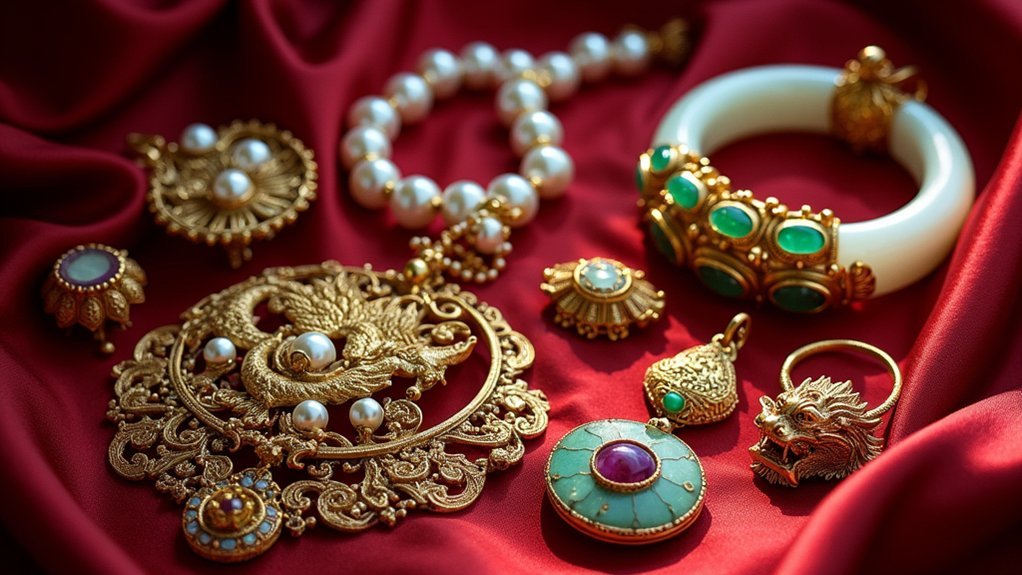
While the foundations of Chinese jewelry can be traced back thousands of years, its evolution through successive dynasties reveals a fascinating story of cultural development and artistic innovation.
You’ll find that Chinese Dynasty jewelry making transformed from the Shang Dynasty’s simple forms into increasingly intricate craftsmanship. During the Zhou era, jewelry became symbols of feudal authority, with enhanced soldering and engraving techniques.
The Han Dynasty’s aesthetic decoration emphasized harmony using silver and gemstones, while Tang artisans created vibrant pieces featuring flowers and mythical creatures. Royal women particularly showcased these evolving styles.
The Neolithic Roots of Chinese Ornamental Traditions
Before the grandeur of dynastic jewelry emerged, China’s Neolithic period established fundamental ornamental practices that would influence millennia of artistic tradition.
You’ll find the earliest Chinese jewelry appearing as simple rings and earrings that served dual purposes—beautifying the wearer while providing spiritual protection.
Neolithic era adornment wasn’t merely decorative; these pieces functioned as powerful amulets believed to repel negative forces and attract prosperity.
The ancient wearer sought not just beauty, but spiritual armor against unseen threats and magnetic attraction for life’s blessings.
Necklaces crafted from natural materials played significant roles in ceremonial contexts, while earrings evolved from practical earplugs to objects of personal expression.
These early ornamental traditions laid vital groundwork for how jewelry would later indicate social status throughout Chinese dynasties.
The symbolic meanings and protective qualities established in this period created lasting cultural patterns that defined Chinese jewelry’s development for centuries to come.
Imperial Court Influence on Jewelry Design and Status Symbolism
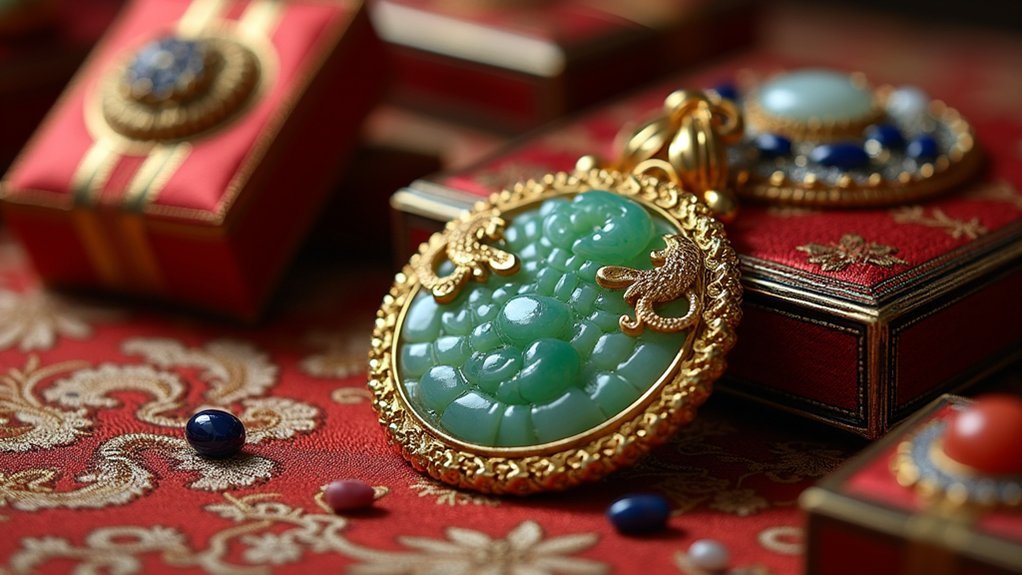
As dynasties rose and fell across Chinese history, the imperial court established an elaborate jewelry system that precisely mirrored social stratification throughout society.
You’d instantly recognize someone’s rank by the jewelry they wore – gold pieces were reserved exclusively for royalty and high officials, while silver adorned those of lesser status.
The imperial court dictated specific designs, materials, and colors appropriate for each social rank. Rings and bracelets given as betrothal gifts conveyed the status of both parties involved.
During the Song Dynasty, women’s earrings evolved from practical items to ornate status symbols crafted from precious materials.
The Qing Dynasty particularly exemplified how jewelry’s intricate craftsmanship served dual purposes: asserting status symbolism while showcasing the court’s artistic achievements and cultural refinement.
Materials Evolution: From Jade Dominance to Precious Metal Integration
You’ll find that jade served as more than mere decoration in ancient China—it represented spiritual purity and cultural identity that defined jewelry for millennia before other materials emerged.
As the Shang Dynasty began experimenting with simple metal forms alongside jade, they set the stage for the material diversity that would later flourish during the Han period.
The gradual integration of silver, gold, and gemstones throughout subsequent dynasties reflects China’s evolving aesthetic sensibilities while maintaining reverence for jade’s sacred position in the culture.
Jade’s Sacred Position
Reverence for jade permeates Chinese cultural history, establishing this luminous stone as the cornerstone of jewelry and personal adornment for millennia. Since Neolithic times, jade has symbolized purity and strength, with its sacred status reaching its zenith during the Shang Dynasty, where it was primarily reserved for ceremonial purposes and afterlife rituals.
Even as the Han Dynasty introduced precious metals like gold and silver to jewelry-making traditions, jade maintained its position as the ultimate symbol of nobility and virtue.
During the Tang Dynasty, you’d find masterpieces of craftsmanship where jade was thoughtfully combined with these metals, creating pieces that honored tradition while embracing aesthetic innovation.
This balance between jade’s cultural significance and evolving materials would continue through the Qing Dynasty, when global trade influenced designs while preserving jade’s sacred position.
Metals Meet Gems
Golden threads of innovation began weaving through Chinese jewelry during the Han Dynasty (206 BCE – 220 CE), marking a pivotal shift from jade’s millennia-long dominance.
You’ll notice how gold and silver suddenly transformed Chinese culture’s approach to adornment, introducing new possibilities for intricate designs while signaling wealth and status.
This material revolution reached its zenith during the Tang Dynasty, when artisans combined colorful gemstones with precious metals, reflecting unprecedented prosperity and cross-cultural exchange.
By the Song Dynasty, craftsmen adopted a more restrained aesthetic, emphasizing natural beauty and spiritual connections between materials and wearers.
While jade never lost its sacred position, these new materials expanded jewelry’s vocabulary, allowing for expressions that balanced tradition with innovation—a hallmark of Chinese artistic evolution.
Symbolic Meanings and Cultural Significance in Dynasty Jewelry
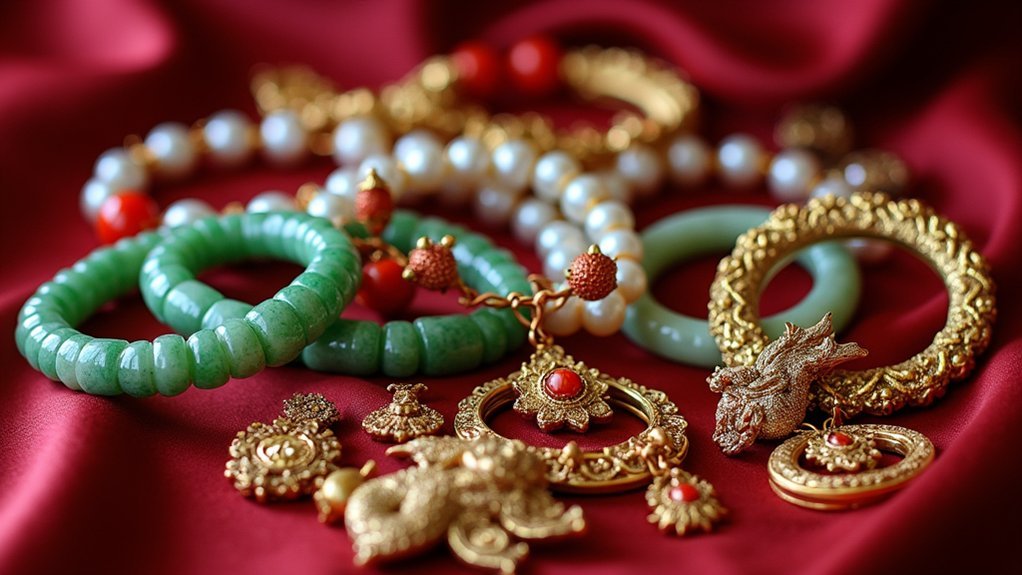
Throughout China’s imperial history, jewelry transcended mere ornamentation to become powerful symbols of social hierarchy and cultural values. When you examine dynasty jewelry closely, you’ll discover how materials and designs directly reflected one’s position in society—gold adorned the elite while silver graced those of lower status.
- Jade pieces symbolized strength and purity, making them essential in ceremonial jewelry.
- Earrings evolved from functional Zhou Dynasty amulets to Song Dynasty symbols of self-discipline.
- Bracelets served as love tokens and betrothal gifts, carrying promises of protection.
- Intricate patterns with dragons represented power within strict cultural hierarchies.
- Color choices, especially red, conveyed specific meanings like good fortune and prosperity.
These symbolic elements weren’t just decorative choices—they were visual languages that communicated social status and spiritual beliefs across generations.
Technological Advancements in Chinese Metalworking Techniques
The evolution of Chinese metalworking represents one of history’s most remarkable technological journeys, transforming from simple bronze casting to sophisticated cloisonné techniques over several millennia. You’ll find that each dynasty contributed unique innovations to jewelry craftsmanship.
| Dynasty | Key Technique | Impact on Jewelry |
|---|---|---|
| Shang | Bronze casting | Created foundational ornamentation |
| Zhou | Soldering, engraving | Enhanced detail in royal insignia |
| Han | Filigree, inlay | Incorporated silver and gemstones |
During the Han Dynasty, metalworking techniques reached unprecedented refinement, with artisans developing methods to create delicate filigree work. The Ming Dynasty’s revolutionary cloisonné enamel techniques involved complex welding processes that produced vibrant jewelry pieces. Later, Qing craftsmen perfected gold threading techniques that showcased both technical mastery and symbolic cultural motifs in Chinese jewelry.
Regional Variations and Ethnic Diversity in Chinese Jewelry Styles
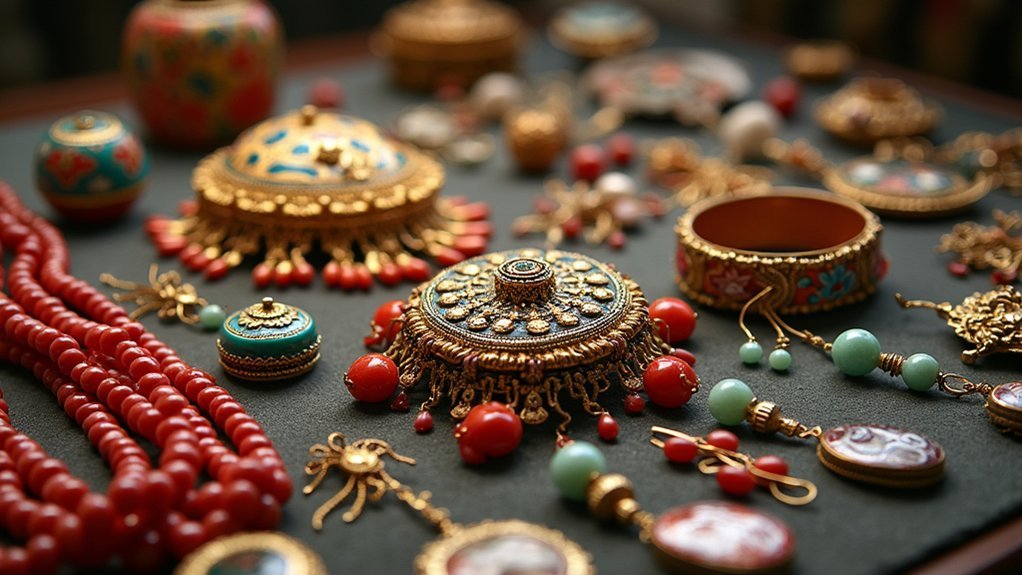
As you explore Chinese jewelry history, you’ll notice striking differences between the elaborate silver ornaments of Miao artisans and the jade-focused creations of Han craftspeople.
These regional variations weren’t merely aesthetic choices but reflected deep cultural beliefs, with dragons symbolizing imperial power in central China while southwestern ethnic groups favored bird and butterfly motifs representing freedom and transformation.
The mountainous terrain of western provinces yielded distinctive turquoise-studded pieces, while coastal regions incorporated pearls and coral, demonstrating how geography directly shaped the materials and techniques found in local jewelry traditions.
Minority Craftsmanship Traditions
While imperial courts dominated mainstream Chinese jewelry aesthetics, diverse ethnic minorities across China’s vast landscapes developed their own distinctive adornment traditions that continue to captivate today.
You’ll find minority craftsmanship traditions showcasing unique jewelry styles that reflect cultural identities through intricate patterns and vibrant colors. These pieces often indicate social status within communities while preserving ancestral techniques through generations.
- Miao silversmiths create elaborate pieces featuring nature-inspired motifs
- Tibetan artisans incorporate turquoise and coral with bold religious symbols
- Regional variations utilize locally-sourced materials like jade and gemstones
- Different styles serve as markers of marital status and community belonging
- Craftsmanship techniques are preserved through oral tradition and apprenticeship
Despite regional differences, these minority traditions share a commitment to meticulous craftsmanship that tells stories of their distinctive heritage and worldviews.
Geographic Style Influences
Throughout China’s vast territory, dramatically different landscapes shaped distinct jewelry traditions that reflect the country’s incredible regional diversity. You’ll find jade prominently featured in northeastern designs, while coastal regions incorporated coral into their ornate pieces.
Geographic diversity directly influenced regional variations in jewelry styles, with each of China’s 55 ethnic groups contributing unique techniques and motifs. The Miao people mastered intricate silverwork, while Tibetan areas in the southwest developed distinctive turquoise and coral settings that expressed their spiritual beliefs.
The Silk Road and other trade routes facilitated cultural exchange, introducing foreign materials that were incorporated into local designs.
During the Qing Dynasty, this fusion reached its peak with Han-Manchu combined styles featuring gold, diamonds, and cloisonné—demonstrating how local materials and ethnic diversity continuously reshaped Chinese jewelry traditions.
Religious and Philosophical Impacts on Ornamental Aesthetics
Chinese dynastic jewelry reveals profound connections between spiritual beliefs and aesthetic expression. When you examine pieces across different eras, you’ll notice how Confucianism’s influence created minimalist designs that valued ceremonial significance over opulence.
Meanwhile, Daoism inspired symmetrical ornamental designs incorporating natural elements to reflect harmony between material and spiritual worlds.
- Buddhist motifs like lotus flowers symbolized purity in Tang and Ming jewelry
- Confucian values promoted simplicity and restraint in Song Dynasty pieces
- Daoist principles of balance manifested in symmetrical compositions
- Religious symbols such as dragons embodied cultural and spiritual ideals during Qing rule
- Philosophical teachings dictated color choices, with red representing good fortune
These spiritual foundations weren’t merely decorative—they transformed jewelry into powerful expressions of China’s religious and philosophical heritage.
Trade Routes and Foreign Influences on Chinese Jewelry Development

Beyond spiritual dimensions, ancient China’s jewelry legacy was equally shaped by its global connections. The Silk Road, established during the Han Dynasty, revolutionized Chinese jewelry design through a vibrant cultural exchange of techniques and exotic materials.
Trade routes connecting China to the Middle East and Europe introduced valuable gemstones like lapis lazuli and turquoise, dramatically enhancing the visual language of Chinese ornaments.
The ancient threads of commerce brought exotic gems that forever transformed China’s artistic vocabulary in precious adornments.
You’ll notice how foreign influences transformed craftsmanship during different dynasties—Tang artisans incorporated Middle Eastern metalworking techniques while Qing designers adapted Persian filigree and Byzantine enameling methods.
This cross-cultural pollination created fascinating hybrid styles that merged traditional Chinese motifs with Western artistic concepts. These international connections didn’t diminish Chinese identity in jewelry but rather enriched it, creating sophisticated designs that reflected China’s place in a connected world.
Frequently Asked Questions
What Jewelry Did the Shang Dynasty Wear?
You’ll find Shang Dynasty people wore jade pendants, bronze bracelets and earrings. They’ve crafted simple yet elegant ornaments that displayed social status, using materials they believed had protective qualities.
What Jewelry Did Chinese Empresses Wear?
You’ll find Chinese empresses adorned themselves with gold rings, jade earrings, protective bracelets, and pearl necklaces like the Ying Luo. Their jewelry showcased their royal status through elaborate, precious materials.
How Did Ancient Civilizations Make Jewelry?
You’ll find ancient civilizations made jewelry through basic techniques like hammering metals, carving stone, threading beads, and casting. They’d shape gold, silver, jade, and gemstones into ornaments using primitive tools and fire.
What Did the Shang Use to Make Their Jewelry?
You’ll find Shang Dynasty jewelry was primarily made from bronze, jade, and shells. They’d also use turquoise and semi-precious stones for inlays, while gold and silver appeared in ceremonial pieces, though less frequently.
In Summary
You’ve seen how Chinese dynasty jewelry evolved through skilled craftsmanship and cultural fusion. From Neolithic jade to imperial gold works, each piece reflects China’s philosophical values, religious beliefs, and social hierarchies. As you explore these treasures, you’ll notice how they’ve been shaped by technological innovation, trade connections, and regional diversity—creating a jewelry tradition that’s uniquely Chinese yet influenced by the wider world.

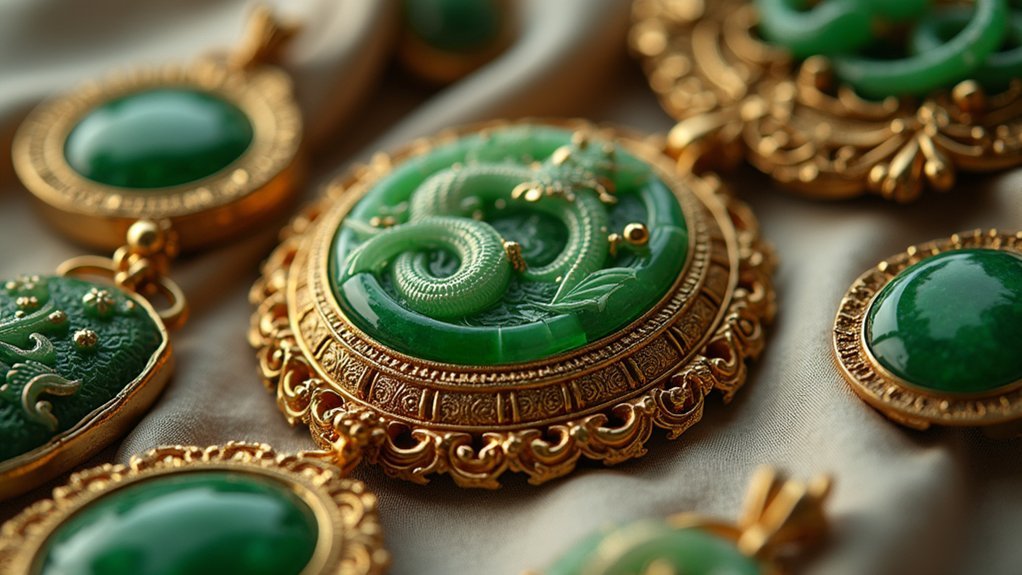


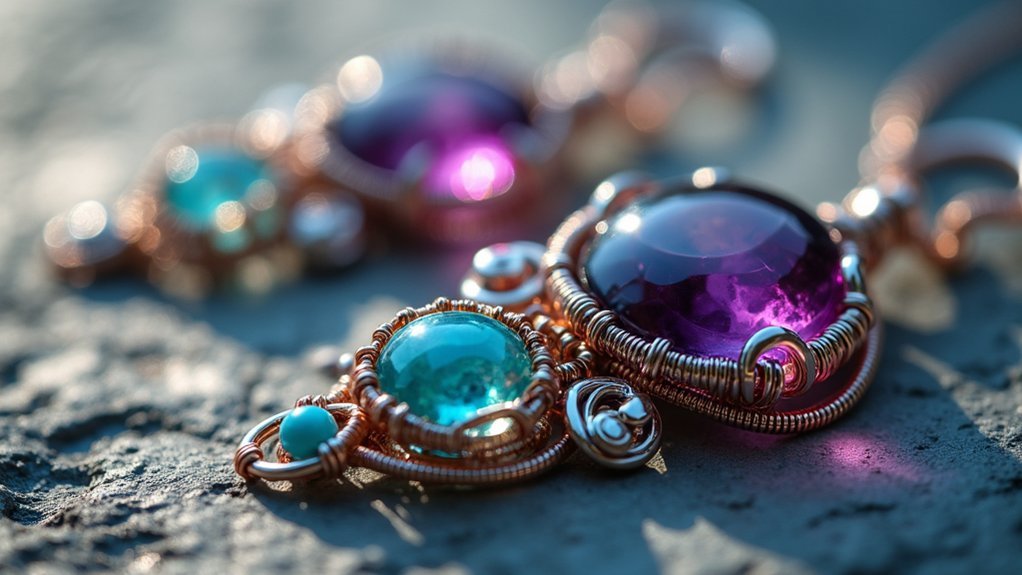
Leave a Reply